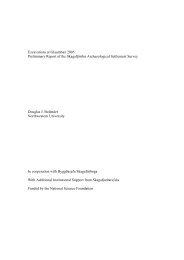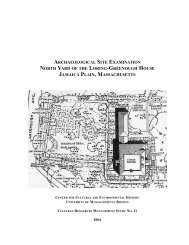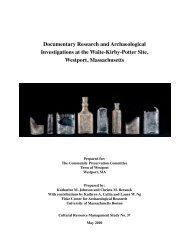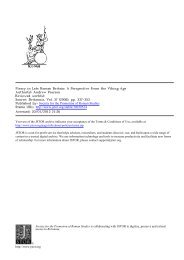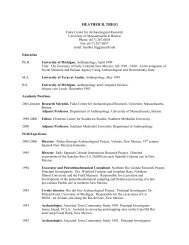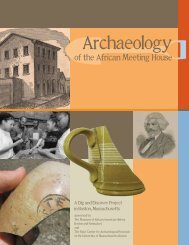Barrett, Locker and Roberts - Fiske Center
Barrett, Locker and Roberts - Fiske Center
Barrett, Locker and Roberts - Fiske Center
You also want an ePaper? Increase the reach of your titles
YUMPU automatically turns print PDFs into web optimized ePapers that Google loves.
James H. <strong>Barrett</strong>. Alison M. <strong>Locker</strong> & Callum M. <strong>Roberts</strong><br />
Whether these goods represent market transactions or indirect subsistence may depend on<br />
one's a priori assumptions, but there is no theoretical basis on which to exclude the former.<br />
In addition to the arguments of Grlerson (1959) <strong>and</strong> Verhulst (2002) cited in the Introduction<br />
above, it is worth noting that recent reassessments ot economic anthropology (including "5<br />
early work on the Trobrl<strong>and</strong> Isl<strong>and</strong>s - on which Dark Age Economics <strong>and</strong> related studies were «<br />
based) also illustrate the co-existence rather than nuitua! exclusion of non-market <strong>and</strong> market S<br />
trade (Gregory 1997:41-70). Secondly, the large-scale Increase In fishing <strong>and</strong> fish trade<br />
coincided with the traditional start of the so-called commercial revolution of the Middle<br />
Ages, around the end of the first millennium (Lopez 1976; Moore 2001:4). It is thus entirely<br />
consistent with a variety of historical indicators. As Fossier (1999:27) has put it, ^'almost all<br />
the observations which one can make, whatei'er the preoccupations of the individual historians,<br />
points to the tenth century as the age oJ growth, oftake-ojjl of rising, or some such phrase."<br />
The importance of the present evidence, however, lies in the fact that it clearly represents<br />
the beginning of an economic phenomenon - rather than simply the earliest historical<br />
documentation of that phenomenon. It is also remarkable that the Hnglish transition to<br />
marine fishing was so rapid, <strong>and</strong> that it seems to represent the clearest change in a timc-scrics<br />
that includes well documented later developments such as Engl<strong>and</strong>'s fifteenth century Icel<strong>and</strong><br />
fishery (Jones 2000). The long-term archaeologicarWisioncs of other bulky low-value products<br />
- such as querns (Parkliouse 1997), meat (O'Connor 2000; Rixson 2000) <strong>and</strong> grain (Rowlcy-<br />
Conwy 1988) - remain to be fully written. For the time being, however, fish bones may join<br />
more traditional materials such as pottery as one of the clearest archaeological indicators of<br />
the distinction between 'Dark Age' <strong>and</strong> later medieval trade.<br />
Appendix 1 (see http://antiquity.ac.uk/ProjGall/barrett/)<br />
Summary information regarding the 127 fish bone assemblages surveyed (see Appendix 2 tor<br />
references).<br />
Appendix 2 {sec http://antiquity.ac.uk/ProjGall/barrcct/)<br />
I'ull reterenccs tor the assemblages surveyed.<br />
Acknowledgements<br />
K:irly versions at this work were presented at the joint Association for Environmental Archaeology <strong>and</strong> North<br />
Atlantic Biocultural Organisation Meeting, Glasgow, in March 2001, [he l<strong>and</strong>scapes <strong>and</strong> Seascapes Conference,<br />
SliL-fVicId, I'cbruary 2002, <strong>and</strong> the International Council for Archaeo/oology Congress, Durhatn, August 2002. We<br />
thank R. Ceron-C^arra.sco, C. Campbell, A. Hall, S. Hamilton-Dyer, D. Jaques, A. Jones, R. Nicholson,<br />
D. Scrjcantson <strong>and</strong> P. Smith for permission to cite forthcoming <strong>and</strong> unpublished /ooarchaeologica! reports. The<br />
YorkCoppergateassemblages were originally published as ubiquity (the proportion of samples in which each species<br />
was noted} rather than NISP data, making quantitative comparison with other sites difficult. For this study, JHB<br />
extracted NISP figures troni tlie original Environmental Archaeology Unit (now Centre for Human Palaeoecology,<br />
York) archive with the permission of Andrew Jones. R. Buckley, J. KIlis, N. Elsden, K. Rieliy,<br />
A. Russel, K. Wade <strong>and</strong> K. White kindly supplied archaeological <strong>and</strong> datitig information. C. Lee <strong>and</strong> A. Sanmark<br />
kindly offered advice regarding fasting regulations. J. Andrews assisted with library research. E. <strong>and</strong> R. Parks translated<br />
Cicrman sources. S. King <strong>and</strong> T. O'Contior kindly commented on an early draft. I^he Etiglish survey was parttiinded<br />
by Hnglish Heritage as part of the Hixborough Project. The Sci>tti.sh comparative example is based on<br />
research funded by 1 lisroric Scotl<strong>and</strong> <strong>and</strong> the Social Sciences iind Humanities Research Council ot (~aiiad,i.<br />
63J



